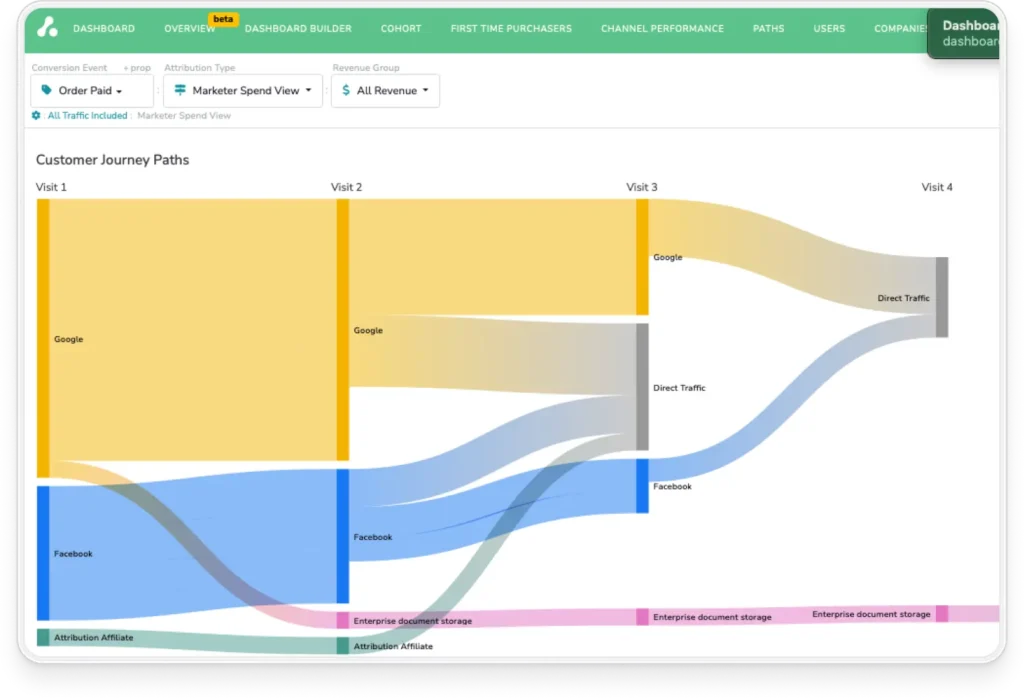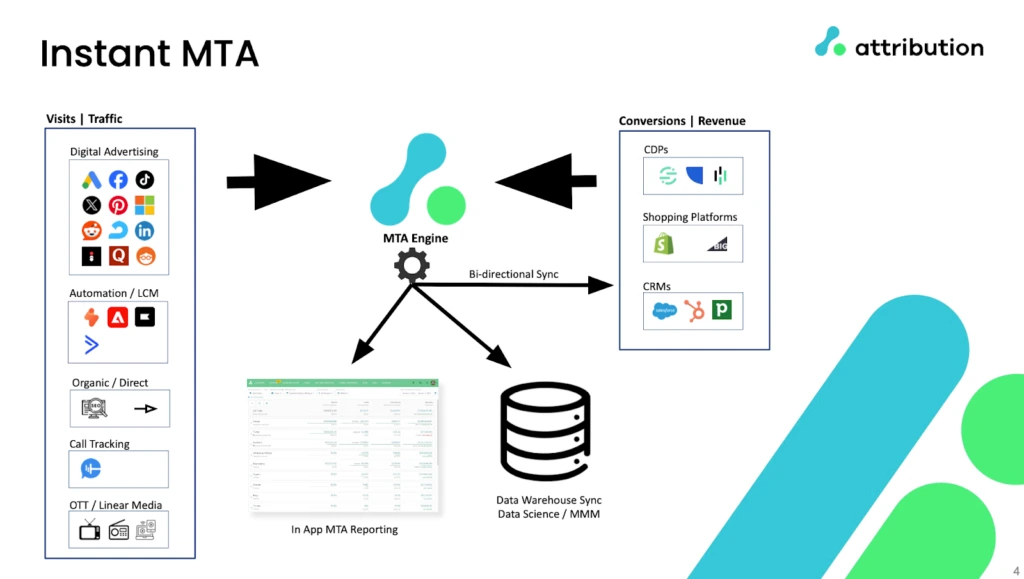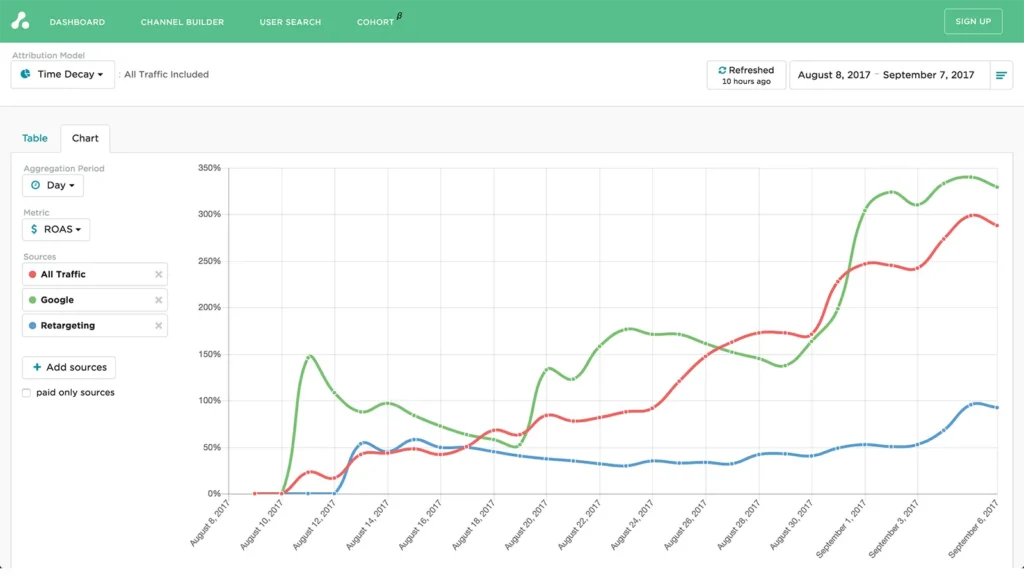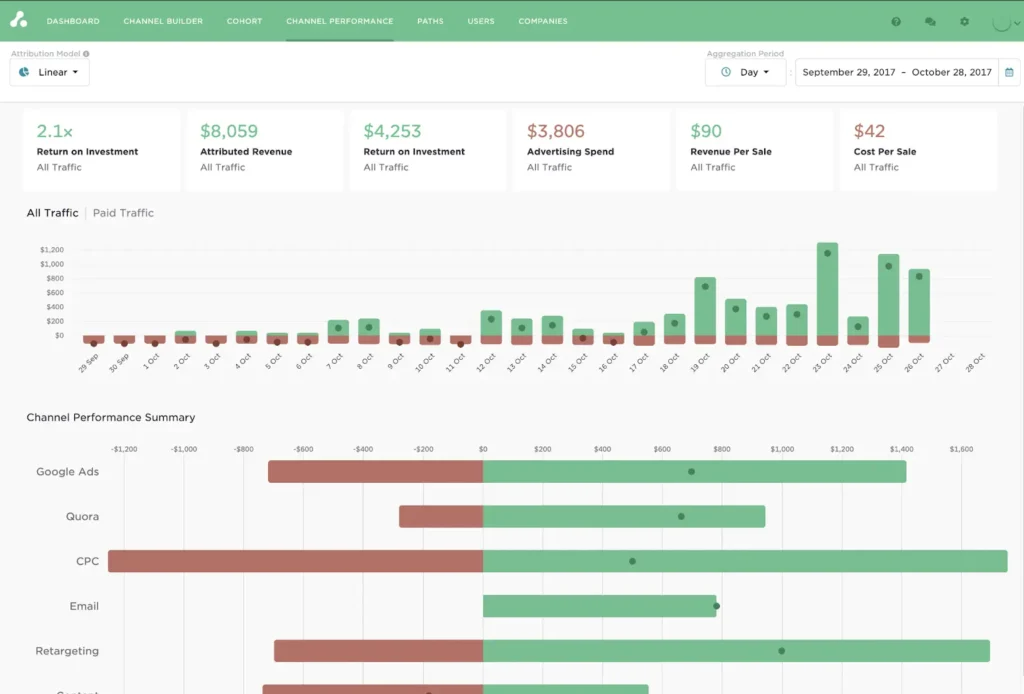If you’re running an account-based marketing program, chances are your attribution model is lying to you.
Not intentionally—but by default. Most attribution systems still assign credit at the lead level, ignoring the messy, multi-threaded reality of how buying decisions happen in B2B. One stakeholder downloads a whitepaper. Another joins a webinar. A third hops on the demo and signs the contract. Traditional attribution gives credit to just one of them.
And that’s the problem. When attribution fails to reflect how buying committees actually behave, you end up with skewed data, misallocated budget, and a disconnect between marketing activity and pipeline reality.
Account-based attribution closes that gap. It reframes measurement around the full buying team—not just the last person to click. But to get it right, you need more than a new reporting toggle. You need connected systems, a shared revenue lens across sales and marketing, and a measurement model that reflects how influence builds over time.
What Is Account-Based Attribution?
Account-based attribution is a measurement approach that tracks how marketing and sales activities influence revenue at the account level—not just the individual lead level.
That shift might seem subtle, but it changes everything.
Traditional attribution models follow a single person through their journey. They might show that Jane from Acme Corp downloaded an eBook and later booked a demo. But what about her colleagues—the VP who clicked a retargeting ad, the procurement lead who opened the pricing sheet, or the CTO who watched your webinar? In complex B2B sales, those touches matter just as much.
Account-based attribution captures that collective engagement. It links all known contacts and touchpoints within a target account to a shared opportunity, creating a unified picture of how the full buying committee interacts with your brand over time.
Switching to account-based attribution gives you:
- True ROI visibility by attributing revenue to the full spectrum of marketing and sales efforts across the account
- Stronger alignment between teams, since marketing and sales now operate from a shared source of truth
- Smarter resource allocation, because you can see which campaigns are resonating with entire buying groups—not just individual leads
If your deals involve long sales cycles, multiple decision-makers, or a mix of online and offline touchpoints, lead-based attribution will always fall short. Account-based attribution gives you the fidelity needed to understand influence at scale—and the clarity to prove what’s working.
Book a Demo
Understand the precise impact of each marketing touchpoint and track “true” CAC, ROAS, and ROI on marketing spend with The Attribution Platform.

Why Marketers Often Struggle with Attribution in Account-Based Marketing
The root problem of attribution in account-based marketing is simply that ABM buying journeys are messy.
Multiple people engage across different channels over long periods of time—and most systems aren’t built to track that kind of complexity. Instead of one clear view of an account’s journey, you end up with disconnected data, incomplete insights, and attribution models that oversimplify how deals actually close.
Four challenges tend to show up again and again:
- It’s hard to identify every stakeholder involved, especially when not everyone engages directly with marketing.
- Data is scattered across platforms, and often tied to individual leads rather than full accounts.
- Offline interactions—calls, events, direct mail—don’t make it into the attribution model.
- And even when you can see the touches, connecting them across long, multi-threaded journeys is no small feat.
The next few sections break these down and show what it really takes to solve them.
Difficulty Identifying All Stakeholders Within Target Accounts
One of the biggest pitfalls in B2B attribution is tracking just one lead per deal. In reality, enterprise buying decisions involve a full committee of researchers, influencers, gatekeepers, and final decision-makers—each playing a different role in the process.
To capture the full picture, you need methods that go beyond form fills. Tools like firmographic matching, email domain grouping, and CRM enrichment can help connect individual contacts to the right account. Lookalike behavior modeling or reverse IP tracking can surface anonymous visitors who are part of the buying group but haven’t raised their hand yet.
Equally important is discovering the hidden influencers—the ones who never convert directly but still tip the scale. A technical stakeholder might forward your whitepaper to their boss. A CFO might only appear on the calendar once for a pricing call. Attribution needs to reflect these contributions, not just the most trackable ones.
Building a unified account profile—where all known contacts and their touchpoints are linked under one organizational view—is foundational. Without it, your model will always be incomplete.
Inability to Connect Disparate Data Sources
Even if you know which people belong to which accounts, the data still needs to talk to each other. That’s where most ABM teams run into friction.
Marketing automation, CRM, paid media platforms, customer success tools—they all track engagement differently. And they often rely on different identifiers (email, user ID, company name, domain) that don’t sync out of the box. As a result, one account might be listed five different ways across your stack.
When systems don’t integrate cleanly, attribution becomes inconsistent at best—and misleading at worst. You might under-credit a high-performing campaign simply because its touchpoints aren’t showing up in your reporting. Or you might double-count interactions from duplicate records.
Solving this starts with consistent account-level identifiers across platforms. Whether it’s domain name, CRM Account ID, or a dedicated CompanyID like Attribution uses, you need a stable way to join everything together. Only then can you build a single source of truth for attribution modeling that reflects the real-world journey.
Linking Multi-Stakeholder, Multi-Touch Journeys to Single Accounts
Here’s the core challenge: every stakeholder has their own journey, their own timeline, and their own preferred channels. One might binge your product blog. Another might come in cold from a LinkedIn ad. A third might only engage after an outbound call from sales.
In a lead-based model, each of these paths gets treated separately. Attribution reports reflect three unrelated journeys instead of one coordinated effort. That disconnect distorts ROI analysis and leads to poor decisions about where to invest.
Account-based attribution reframes the model to match the reality: multiple people, multiple touchpoints, one deal. But bringing those paths together into a unified, multi-touch view requires more than toggling a report setting. You need clean data, cross-functional alignment, and a multi-channel attribution model that can accommodate long, non-linear decision cycles.
When done right, this approach doesn’t just give you better analytics. It gives you better strategy. You’ll understand which plays are moving the entire account forward—and where influence is falling short.
6 Best Practices for Account-Based Attribution
Solving attribution in an ABM context doesn’t start with picking a model—it starts with fixing the foundation. From unifying your data to aligning teams and tracking what actually moves deals, the practices below help you build an attribution system that reflects how buying really happens.
Let’s break down what works.
1. Integrate All Key Systems for a Unified View
The most common failure point in ABM attribution? Siloed data.
Your CRM tracks opportunity stages. Your marketing automation platform tracks engagement. Ad platforms know who clicked—but not what happened next. If you don’t unify those systems, you’ll never get a reliable picture of what’s actually driving revenue.
To build a single source of truth, make sure you’re capturing:
- A consistent account identifier (like domain or CRM Account ID)
- Contact roles and job titles to differentiate influencers from buyers
- Touchpoint details like timestamp, channel, and asset engaged

You don’t need to boil the ocean—just make sure all systems are speaking the same language.
(As an aside, note that the Attribution Platform uses a unique [CompanyID] to automatically group users under one account. So, if three different people from an org engage at different stages, those touches roll up into one cohesive journey. No duplicate records and no attribution gaps.)
2. Adopt an Account-Centric Measurement Approach
Lead-based attribution falls apart in ABM. Why? Because leads don’t buy—accounts do.
That’s why your metrics need to shift from individual conversion events to collective account behavior. Start by rethinking your success indicators:
| Instead of measuring… | Track… |
| MQL count | Number of engaged accounts |
| Lead scores | Account engagement score |
| Lead-to-opportunity rate | Pipeline velocity by account |
Making this shift includes analyzing multi-threaded journeys, meaning different people engaging with different content across different timelines.
3. Align Sales and Marketing Around Shared Account Goals
ABM attribution works best when sales and marketing operate from the same playbook.
That means more than shared dashboards. It means:
- Defining what counts as an “engaged account”
- Agreeing on target KPIs (e.g. pipeline influenced, win rate, velocity)
- Running regular joint reviews of attribution data to adjust strategy in real time
When both teams understand the full account journey—and how each function contributes to moving it forward—you avoid turf wars and focus on impact.
4. Choose a Multi-Touch Model Tailored to Your Business’s Customer Journey
If your attribution model gives 100% credit to a single touchpoint, it’s not built for ABM.
Account-based journeys are long, nonlinear, and multi-threaded. You need a model that reflects that complexity—especially if you’re trying to measure influence across a buying committee.
Some common multi-touch models to consider:
- Linear: Equal credit to all touches. Good for visibility, but flattens nuance.
- U-shaped: Also called position-based attribution, this model emphasizes first touch and lead conversion. Useful if you’re optimizing for early-stage influence.
- W-shaped: Adds weight to opportunity creation. Strong for full-funnel programs.
- Time-decay: More credit to recent touches. Useful for long sales cycles.
- Custom attribution model: Tailored to your historical performance and customer behavior.
Always start with the model that matches your funnel stage priorities. For example, if your primary focus is effective pipeline creation, a W-shaped model might be a strong starting point. As you collect more data, revisit your model quarterly to see if it still reflects how deals actually close. The right model should evolve with your strategy—not stay static.
5. Integrate Online and Offline Touchpoints
Some of your most valuable ABM interactions happen offline—at dinners, trade shows, in sales calls—but never show up in your attribution reports.
To get a complete view of account engagement, you need to pull these into your measurement framework. Here’s how:
- Track offline sales activity in your CRM (e.g., meeting notes, phone calls, field events)
- Use unique URLs, promo codes, or QR codes to connect direct mail or physical collateral back to digital behavior
- Log event attendance and associate it with account records, even if no digital action follows
It’s important to note that your offline touchpoints don’t need to be measured perfectly. They just need to be counted consistently. Even a simple tagging system (“executive dinner – month,” “in-person demo”) can dramatically improve your visibility into account movement.
6. Utilize Predictive Engagement Scores to Gauge How Close Accounts Are to Converting
Not all account activity means momentum. Some signals matter more than others.
That’s where predictive engagement scoring comes in. By analyzing historical touchpoint patterns—who engaged, in what way, and in what order—you can estimate how likely an account is to convert.
A solid predictive model factors in:
- Volume and recency of engagement
- Engagement depth (e.g., watched a webinar vs. skimmed a blog post)
- Stakeholder mix (e.g., is a decision-maker involved?)
The result? A prioritized list of accounts, ranked by intent—not just activity.
How The Attribution Platform Simplifies Account Based Attribution

Most attribution tools were built for lead-based funnels. The Attribution Platform, by contrast, is designed with account-based measurement in mind. It gives B2B teams the tools necessary to track, analyze, and optimize multi-stakeholder buying journeys from start to finish.
There are four specific ways that the Attribution Platform can help clarify your ABM attribution.
Group users into accounts with CompanyID
Attribution uses a unique CompanyID system to automatically associate contacts with the right organization. This ensures that multiple stakeholders from the same company—regardless of when or how they engage—are tracked under a single account record.
Whether it’s an intern downloading a guide or a VP joining a demo, those touchpoints roll up into one unified timeline for that account. No duplicate records, no guessing who’s connected to what deal.
Toggle between lead and account views
Traditional attribution tools force you to choose between lead-level and account-level reporting—or worse, require custom code to get both.
Attribution makes this flexible by offering an account-centric toggle. With one click, marketers can shift from analyzing individual user journeys to seeing how entire accounts are progressing through the funnel. That makes it easier to serve both ABM and traditional demand gen programs from the same system.
Capture multi-touch journeys across entire buying committees
The platform supports a full range of attribution models—linear, time-decay, W-shaped, custom, and data-driven—so you can assign credit accurately across complex buying journeys.
More importantly, it enables:
- Credit for both online and offline touches (via integrations with CRM and sales activity logs)
- Consistent visibility into how each campaign contributes to pipeline and revenue
- Cohesive reporting across every contact and touchpoint tied to an account
This makes it possible to move beyond simplistic, last-click logic and actually understand how deals are influenced over time.
Optimize spend and prove impact with account-level ROI
Once attribution is set up, the platform becomes more than just a reporting tool—it becomes a strategic resource.
You can track:
- Which campaigns are influencing high-value accounts
- How quickly target accounts are moving through the funnel
- What combination of touches leads to conversion within different segments
That clarity gives marketing and revenue teams the confidence to double down on what’s working—and adjust spend where it isn’t.
Sign up and try Attribution today — pinpoint CAC by channel, audit funnels and conversion rates, scale revenue-driven content marketing, measure affiliate LTV and CAC (and more).

Account Based Attribution FAQs
How does account based attribution differ from traditional attribution models?
Traditional attribution models focus on individual leads—they assign credit based on one person’s interaction with your brand. Account-based attribution shifts that lens to the company level. Instead of tracking isolated user journeys, it captures the full set of interactions across everyone involved in a deal. This approach reflects how B2B purchases actually happen: as a group decision influenced by multiple stakeholders over time.
Which metrics matter most for account based attribution?
With account-based attribution, the most meaningful metrics reflect engagement and progression at the account level. That includes:
- Account engagement score (aggregated activity across contacts)
- Pipeline influenced by marketing
- Opportunity creation rate by account
- Velocity through key stages
- Account-level ROI
These metrics help you understand not just who is interacting, but how effectively you’re moving target accounts toward revenue.
How can you connect offline touchpoints to your account based attribution?
Offline interactions—like field events, sales calls, or direct mail—can be just as influential as digital ones. To include them in your attribution model:
- Log activities consistently in your CRM (with contact, date, and type of touchpoint)
- Use trackable assets like QR codes or promo codes tied to specific campaigns
- Import attendance lists or interaction data from events into your attribution tool
- Categorize offline actions (e.g. “Sales Call,” “Trade Show Visit”) so they can be weighted and analyzed alongside digital touches
The goal isn’t perfect precision—it’s structured inclusion. Capturing these moments ensures your attribution reflects the full scope of engagement
